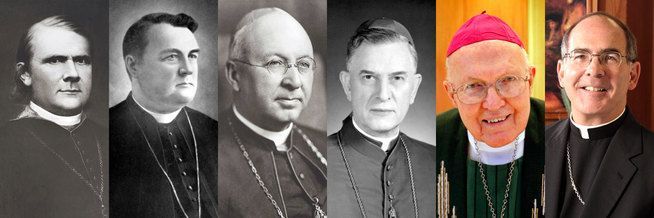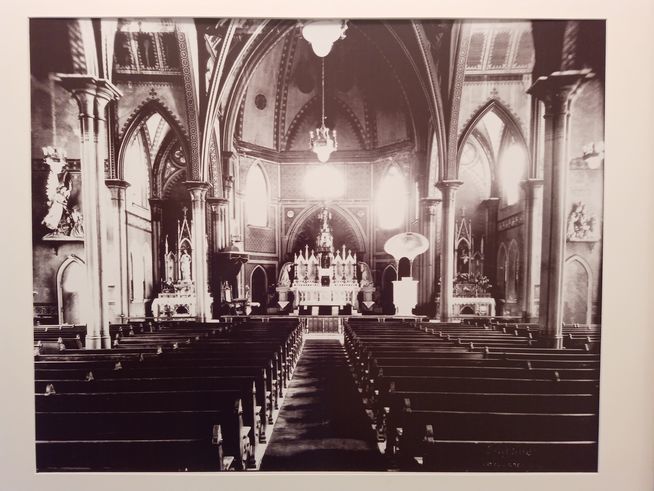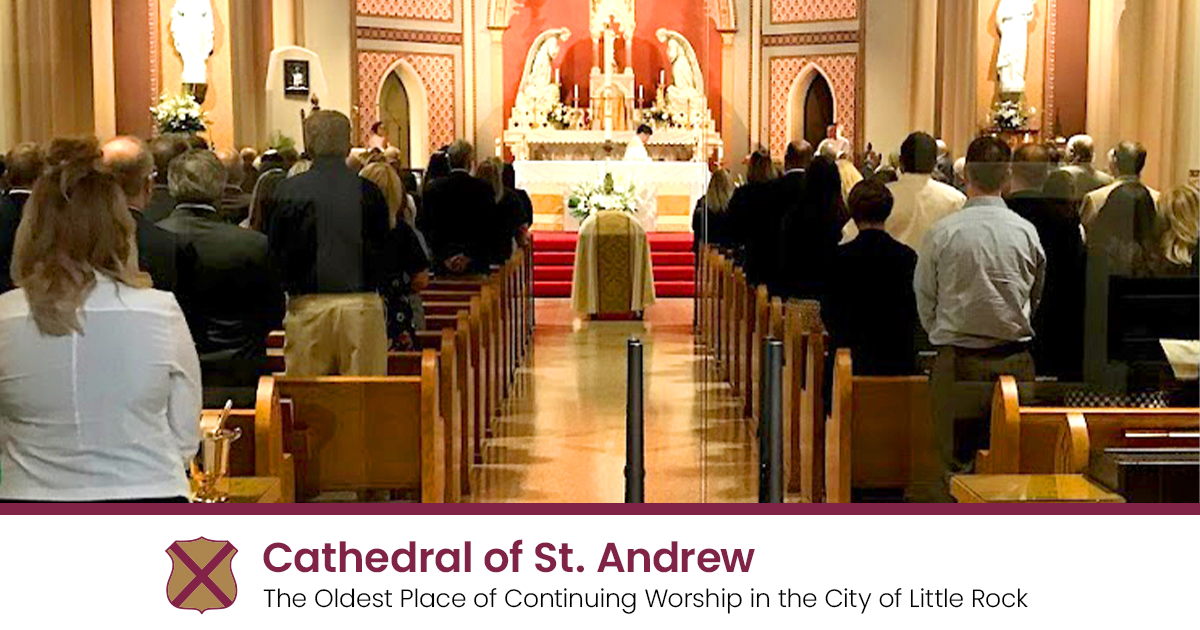Cathedral History
History of the Cathedral of Saint Andrew

Former Bishops (From Right to Left in above picture) Archbishop J. Peter Sartain — 2000-2006; Bishop Andrew J. McDonald — 1972-2000; Bishop Albert L. Fletcher — 1946-1972; Bishop John B. Morris — 1907-1946; Bishop Edward Fitzgerald — 1867-1907; Bishop Andrew Byrne — 1844-1862
Named after Andrew, the brother of Peter, and the first of the apostles called by Jesus...
Welcome to the Cathedral of St. Andrew, named after Andrew, the brother of Peter, and the first of the apostles called by Jesus. This church is listed on the National Registry of Historic Places. The history of the Cathedral of St. Andrew dates back to the early part of the 19th century, when Catholics in Arkansas were few in number and bigotry and prejudice were very strong against the Church. Little by little, through the persistent efforts of the bishops and priests of the Cathedral, progress was made until now, over 150 years later, the Cathedral stands as a symbol of faith, fidelity and family to the Catholics of the Diocese of Little Rock, the state of Arkansas.
The early history of the Cathedral parish began with the coming to Little Rock of the priests from the Diocese of St. Louis. According to church records, the first Mass celebrated in Little Rock was celebrated by Fr. Peter Donnelly in 1830, in a room over Dugan's Store at 2nd and Main Streets. As the number of Catholics grew, a building on East Markham near Third Street was later used for religious purposes. In 1839, Fr. Joseph Richard Bole and Fr. Paris were sent to Little Rock to build a permanent structure on the grounds formerly occupied by the Arcade Building between 6th and 7th Streets on Louisiana.
This property which was donated by Colonel Chester Ashley, is directly opposite the site of the present Cathedral. This first Catholic Church erected in Little Rock was plain but comfortable. In the spring of 1841, the church was dedicated by the Most Reverend Bishop Loras of Dubuque, Iowa, and at that time was called the "Old French Church." Later in the same year, a convent was built for the Sisters of Loretto who opened a school for day pupils. In 1843, Arkansas was separated from the Diocese of St. Louis and the Diocese of Little Rock was established by Rome, and on March 10, 1844, the Most Reverend Andrew Byrne was consecrated as the first Bishop of Little Rock.
In 1845, Bishop Byrne purchased property at 2nd and Center Streets and there he erected the first St. Andrew's Cathedral. The architect for the original small Cathedral was Malacha Abbott. The first Mass in the new Cathedral was offered on November 1, 1845, when Bishop Byrne consecrated the Cathedral under the patronage of St. Andrew the Apostle.
Fr. Patrick Reilly was appointed the first rector of the Cathedral and labored most zealously for the people of the parish, who treasured his efforts. After 29 years of service to the Cathedral, his health became seriously impaired and, upon the advice of his physician, he returned to Ireland in 1879, where he died in 1882. As a memorial to Father Reilly, the bell in the tower was dedicated in his honor in 1886. It was made by the McShane Bell Foundry in Baltimore. It is said to be the largest bell in Little Rock, weighing 3300-3400 pounds. (Pulaski Country Historical Review (Winter 1994, vol.42, n.4, p. 83). From 1890 until 1944, this bell was part of the city’s fire alarm system.
Realizing the need for co-workers in the cause of the Catholic Church in Little Rock, Bishop Byrne went to Ireland to secure a community of the Sisters of Mercy to serve in his Diocese. On November 30, 1850, Bishop Byrne and the eleven Sisters of Mercy sailed for home. They arrived in Little Rock on February 5, 1851, and upon their arrival the Bishop surrendered his home adjoining the Cathedral for their use. At that time the parish roster numbered twelve families. The Sisters of Mercy opened a day school with an attendance of 35 pupils, nearly all of whom were non-Catholics. A Sunday school was also opened at that time with two children in attendance.
After the completion of the Cathedral on West Second Street, the Sisters of Mercy took up residence in the "Old French Church" at the corner of 7th & Louisiana. As the parish grew, a larger building was erected on the corner of 6th & Louisiana. The old Cathedral at 2nd & Center Streets, built by Bishop Byrne in 1845, was eventually too small for the congregation. The cornerstone of the new Cathedral at 7th & Louisiana was laid on Sunday, July 7, 1878, by Bishop Edward Fitzgerald and Archbishop Patrick John Ryan, who preached the sermon. Construction began in 1878 and the Church was dedicated the first Sunday of Advent, November 27, 1881.

On November 30, 1881, the Feast of St. Andrew the Apostle, Bishop Fitzgerald had the remains of Arkansas’ first bishop, the Right Rev. Andrew J. Bryne, removed from Helena, Arkansas and brought to the new Cathedral. The new Cathedral measures 140 feet in length and 86 feet across the transept made of wood from around the state. The walls are 36 feet high, the style is English Gothic, and the material is native gray granite, quarried at nearby Fourche Mountain, south of Little Rock. It was said that this church was one of the first buildings in Arkansas built entirely of native granite. There are two towers, the tallest one reaching 231 feet, completed in 1887. The bishop ordered work on the southwest steeple to be discontinued until the local Masonic Temple was constructed so that the Cathedral’s steeple would be higher.
On Passion Sunday 1950, a small tornado struck downtown and toppled the 900 pound cross from its lofty spire. The following year a larger cross of bronze weighing 400 pounds was erected. The church is constructed in the form of European cathedrals, in the shape of a Latin cross. The center section is called the nave, while the cross section is called the transept. According to tradition, the main altar and the congregation face east and the main doors are on the west facade. The transept runs north and south.
The church structure has twelve quadralobe pillars, six on either side, supporting the roof, symbolic of the twelve apostles holding the foundation of the Church. The Gothic arch, which was developed in the tenth and eleventh centuries to support high walls, allowing for more light from the stained glass windows, is prominently used in the windows and doorways. The main windows are 13 feet wide and 28 feet high, while the side windows measure 5 by 22 feet. These stained glass windows illustrating saints of the Church (Immaculate Conception, Aloysius, Augustine, Charles Borromeo, Edward, Agnes, Helena, John the Baptist, Patrick and Hedwig) and the Last Supper came from the New York office of Mayer of Munich. All of the stained glass windows are original except the right middle pair of St. Thomas Aquinas and St. Albert Great, which were damaged in the 1950 tornado.
The interior is finished in native wood, Southern yellow pine, and the roof is crafted of exposed timbers, with the original gold stenciling still remaining. The magnificent main marble altar, decorated with onyx and other precious stones, was the gift of Mr. and Mrs. Alexander Hager, costing about $3,000. The total cost of the Cathedral at that time exceeded $470,000, and most of these funds were acquired by Bishop Fitzgerald outside of the diocese. The architect for the Cathedral was Mr. Thomas Harding of Little Rock. The congregation at that time numbered 1500.
Interior finishing was added to the building which included the Stations of the Cross, fresco work, a new pipe organ, and a Sanctuary Lamp. Along the walls are the 14 Station of the Cross representing the suffering and passion of Jesus. These Stations are large in proportion to the size of this Cathedral because they were originally designed for Holy Name Cathedral in Chicago, Illinois, which was being constructed at the same time. The mix-up was never corrected.
On June 11, 1906, the Most Reverend John B. Morris, Vicar General of the Diocese of Nashville, Tennessee, was consecrated Coadjutor Bishop of Little Rock. Shortly after his arrival in Little Rock, Bishop Fitzgerald, who had been in failing health for some years, died in Hot Springs on February 21, 1907. Bishop Morris succeeded to the See of Little Rock.
The original organ was renovated in 1916, when four distinct organs were used, consisting of the “Pedal organ,” an “Echo organ” in the south transept, the “Swell organ,” the “Great organ.” It was in 1931, during the Great Depression, that $20,000 was raised to purchase a magnificent new Moller organ consisting of more than 3,000 pipes and 25 bells. This instrument, which consumed most of the space of the choir loft, was hailed as perhaps the finest organ in the state of Arkansas at that time.
In December of 1923, because of the increasing attendance of the Cathedral School, it was necessary to purchase additional property to provide for the future growth of a new school. The spacious home and grounds of John M. Gracie on East Sixth Street was purchased for $60,000. After suitable alterations had been made, the new school was blessed by Bishop Morris in January of 1924. The Cathedral School which had been under the direction of the Sisters of Mercy, later came under the capable direction of the Olivetan Benedictine Sisters of Jonesboro, Arkansas. The exodus of parishioners who were moving out of downtown to Pulaski Heights and western Little Rock, resulted in the closing of the Cathedral of St. Andrew School in 1962, and the selling of the school building.
Upon the death of Bishop Morris in 1946, the Most Reverend Albert L. Fletcher, Auxiliary Bishop of the Diocese, was appointed to succeed as bishop. In 1941 the St. Andrew's Parish Hall at 9th and Louisiana was built. In September of 1947, extensive repairs had to be made to the roof, walls, and steeple at a cost of approximately $50,000. Although the Cathedral's exterior remains practically the same, the interior has changed throughout the years. Beneath the vestibule floor was once the original crypt where the bishops were entombed until 1962, when a new crypt was constructed downstairs in the north transept of the Cathedral.
The four former bishops of Arkansas entombed there are: Andrew Byrne, Edward Fitzgerald, John Morris, and Albert Fletcher. Each tomb is marked with a plaque giving the bishop’s name, place of birth, ordination of priesthood and episcopacy, and where he died. The first two are in Latin as was the custom of the earlier Church. Their individual Coat of Arms are also displayed on the plaque.
A new rectory was built in 1966, replacing the original Victorian bishop’s residence. Msgr. McDevitt oversaw the extensive renovation of the Cathedral Church in 1975, incorporating the liturgical changes brought about by the Second Vatican Council. In 1972, when Bishop Fletcher retired, Pope Paul VI appointed Msgr. Andrew J. McDonald of Savannah, Georgia, to be the fifth Bishop of Little Rock, and the Cathedral was the scene of his installation on September 7 , 1972.
Three years later, with $190,000 contributed in memorials, the Cathedral underwent its most extensive renovation. The sanctuary was expanded into the apse, a new altar of sacrifice was installed and high spired wooden screens were set behind the original altar where the Holy Eucharist is still reserved in the tabernacle. The original back Altar, made of Italian marble, was modified in 1975 having some of the ornate towers removed.
